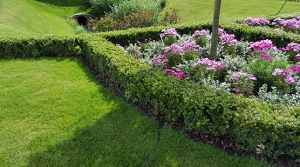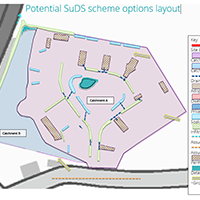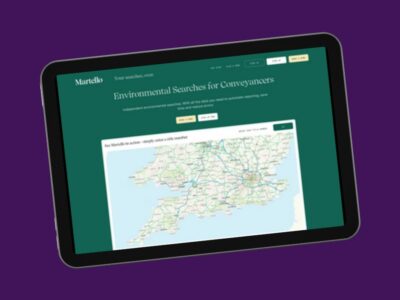Sustainable Drainage Scheme conditions – what they look like and how to approach them – Part 1
When submitting planning applications, a council will often impose a condition to be met in order for the development to go ahead. The need to assess the inclusion of a sustainable drainage scheme (SuDS) is increasingly part of these requirements.
In the first of 2 blogs, we look at typical examples of conditions and how we can support property professionals in providing clearer answers that help assess meeting these conditions to gain planning approval.
Conditions relating to SuDS are typically applied to planning applications where the Site is part of what is termed a major development or where the Site is at risk of flooding from sources such as pluvial, fluvial/tidal, groundwater and artificial sources such as reservoirs and canals.
Examples of Sites that would receive a SuDS condition are:
- Residential development where there are 10 dwellings or more (termed major development)
- 10 dwellings or more; or equivalent non-residential or mixed development;
- Commercial development where the floor area is greater than or equal to 1000 sq/m (termed major development)
- Site is located in an area of flood risk (guidance states “new development should only be considered appropriate in areas at risk of flooding if priority has been given to the use of sustainable drainage systems”.)
- development carried out on a site having an area of 1 hectare or more

Temporary inflow with landscaped watercourse
What does a condition look like?
The exact wording of conditions can vary from council to council. Below are three examples of typical conditions, noted on several decision notices we have encountered across the country:
Condition Type 1
Prior to the commencement of the construction of the dwellings details of surface water drainage works shall be submitted to and approved in writing by the Local Planning Authority. Before these details are submitted an assessment shall be carried out of the potential for disposing of surface water by means of a sustainable drainage system and the results of the assessment provided to the local planning authority. Where a sustainable drainage scheme is to be provided the submitted details shall:
- provide information about the design storm period and intensity, the method employed to delay and control the surface water discharged from the site and the measures taken to prevent pollution of the receiving groundwater and/or surface waters;
- include a timetable for its implementation; and
- provide a management and maintenance plan for the lifetime of the development which shall include the arrangements for adoption by any public authority or statutory undertaker and any other arrangements to secure the operation of the scheme throughout its lifetime. Prior to the occupation of the buildings hereby approved the surface water drainage works shall be carried out and the sustainable drainage system shall thereafter be managed and maintained in accordance with the agreed management and maintenance plan.
Reason: To ensure that surface water does not discharge into the surface water sewer and to provide a sustainable development.
Condition Type 2
Prior to building work starting on site, a scheme for the management of surface water runoff must be submitted to the Local Planning Authority and approved in writing which identifies appropriate site drainage and flood risk management measures, including SUDS, in order to manage surface water runoff as close to its source as possible in line with the Mayor’s drainage hierarchy. The proposed scheme should aim for a greenfield runoff rate and, as a minimum, achieve a 50% attenuation of the site’s surface water runoff for all storm events up to and including the 1 in 100 year 6-hour event (plus 30% for climate change); ensure that the runoff rate at peak times is no more than three times the calculated greenfield rate; and ensure a minimum discharge rate of 5 litres per second per outfall. Consideration should be given to green roofs, walls or site planting measures where feasible.
Reason: To comply with Policy XX of the Site Development Policies DPD.
Condition Type 3
The development shall not commence until details of surface drainage works have been submitted and approved in writing by the Local Planning Authority. The details shall be based on an assessment of the potential for disposing of surface water by means of a sustainable drainage system in accordance with the principles as set out in the Technical Guidance to the National Planning Policy Framework and shall be designed to a 1 in 1 and 1 in 100 year storm event allowing for climate change to include a full maintenance and management plan. The drainage system shall be installed/operational prior to the first occupation and the approved management and maintenance plan put in place to ensure its continued function over the lifetime of the development. The development shall be carried out strictly in accordance with the details so approved and maintained as such thereafter.
Reason: To ensure the sustainable management of water, minimise flood risk and to minimise discharge of surface water outside of the curtilage of the property in accordance with Policy CP28 of the Core Strategy, Policies 5.12 & 5.13 of the London Plan and the NPPF.
Criteria 1: Preliminary SuDS feasibility report
A preliminary SuDS feasibility report identifying:
- The existing and proposed Site layouts.
- The topography of the existing and proposed Site (if known).
- The context of the Site in relation to natural and man-made features such as the underlying geology, surface watercourses, flood risk, development within the vicinity such as buildings and sewers.
- The existing and proposed surface water runoff rates and volumes from the Site.
- The feasibility of alternative discharge points in accordance with the drainage hierarchy.
- The Local Council’s preferred method of surface water disposal and rate of discharge in the context of the Site.
- The proposed future use of the Site in terms of water quality and the levels of treatment required before disposing of surface water.
How can these conditions be met?
 The starting point is to undertake a SuDSmart Pro Report. This is a preliminary feasibility report that uses all available desk based resources, including GeoSmart’s SD50 (SuDS Infiltration) Map, to characterise the Site and the risk it poses to future occupants and the surrounding environment.
The starting point is to undertake a SuDSmart Pro Report. This is a preliminary feasibility report that uses all available desk based resources, including GeoSmart’s SD50 (SuDS Infiltration) Map, to characterise the Site and the risk it poses to future occupants and the surrounding environment.
Our SuDSmart reports follow the drainage hierarchy outlined within the CIRIA SuDS manual and incorporate local guidance relevant to surface water discharge to come up with an outline drainage strategy recommending the most feasible options for the Site.
For more guidance on planning authority SuDS Guidance, please refer to our online library.
In the next part, we’ll revisit the criteria set by the planning authority for a feasibility report and take you through step by step how we support our customers in answering these questions.



